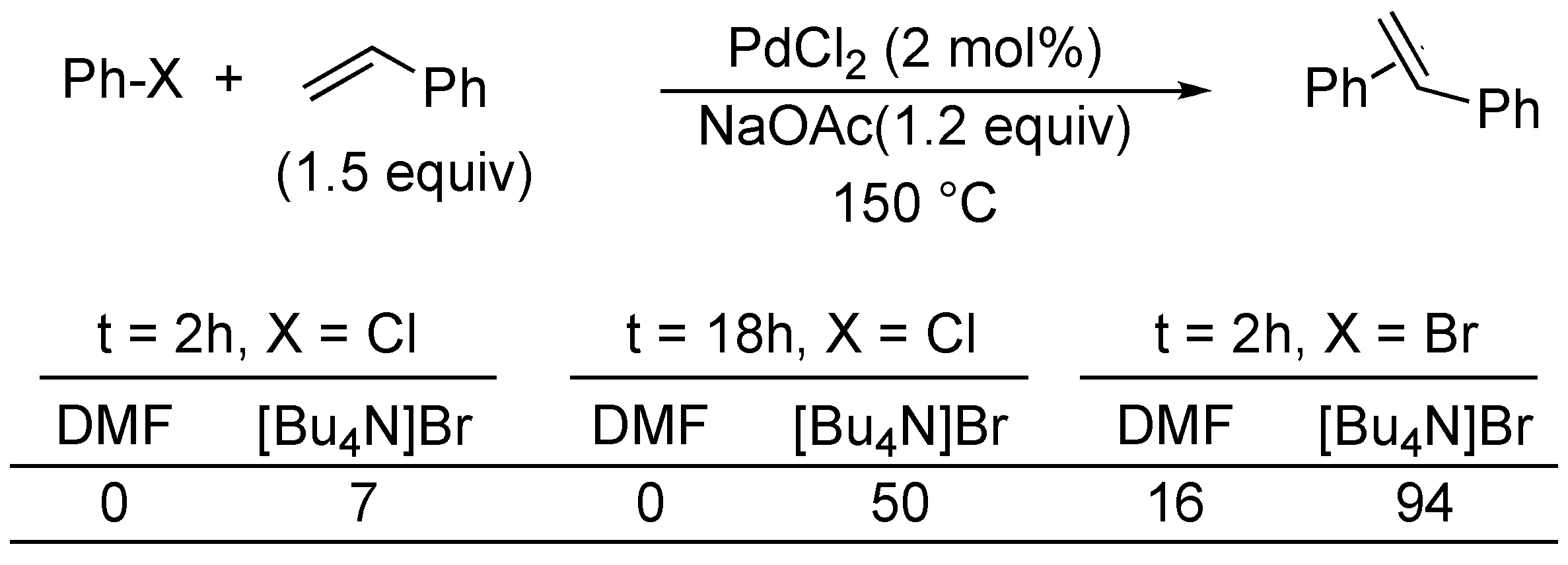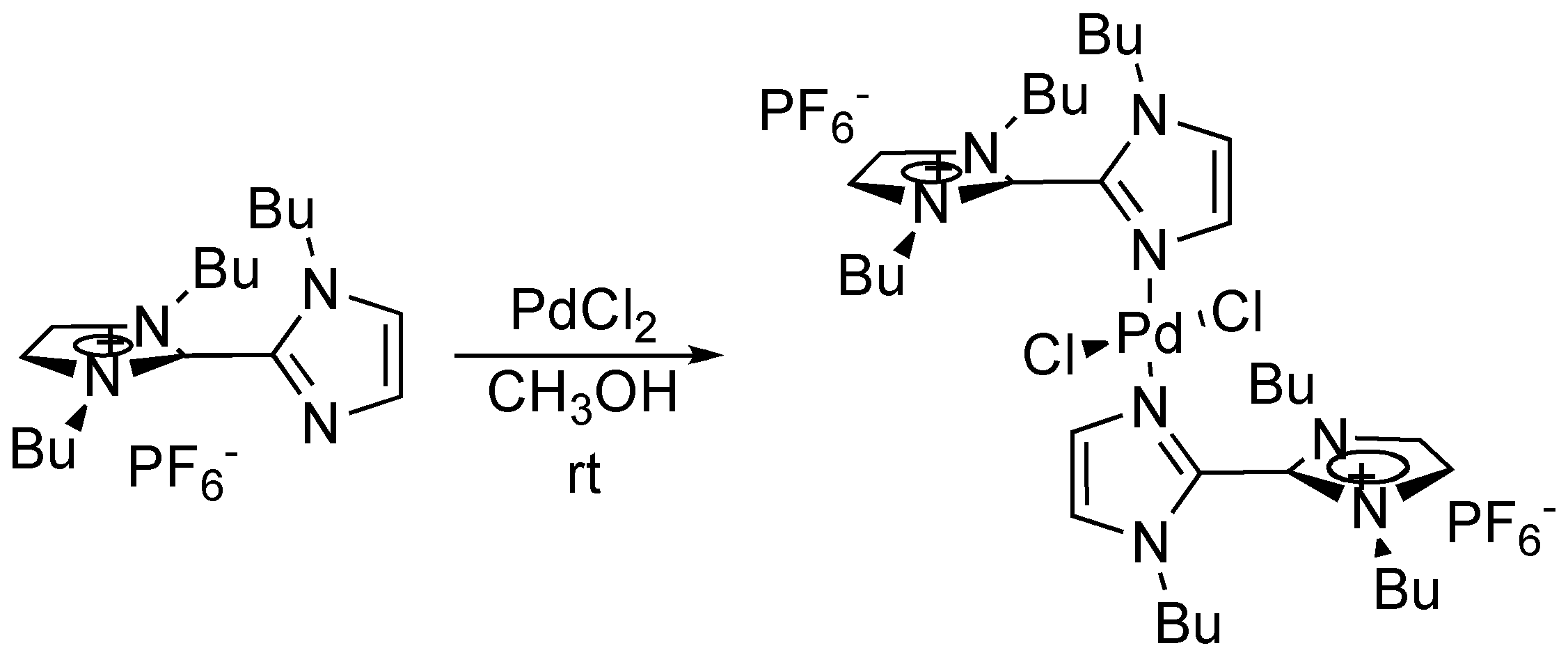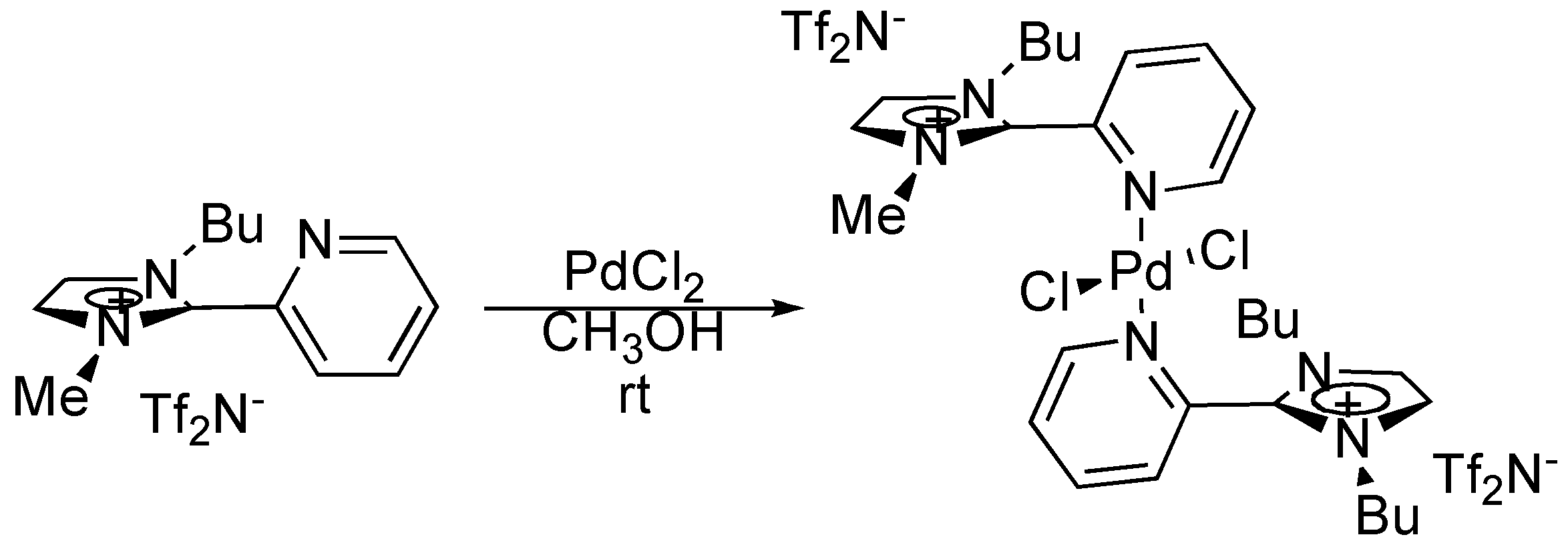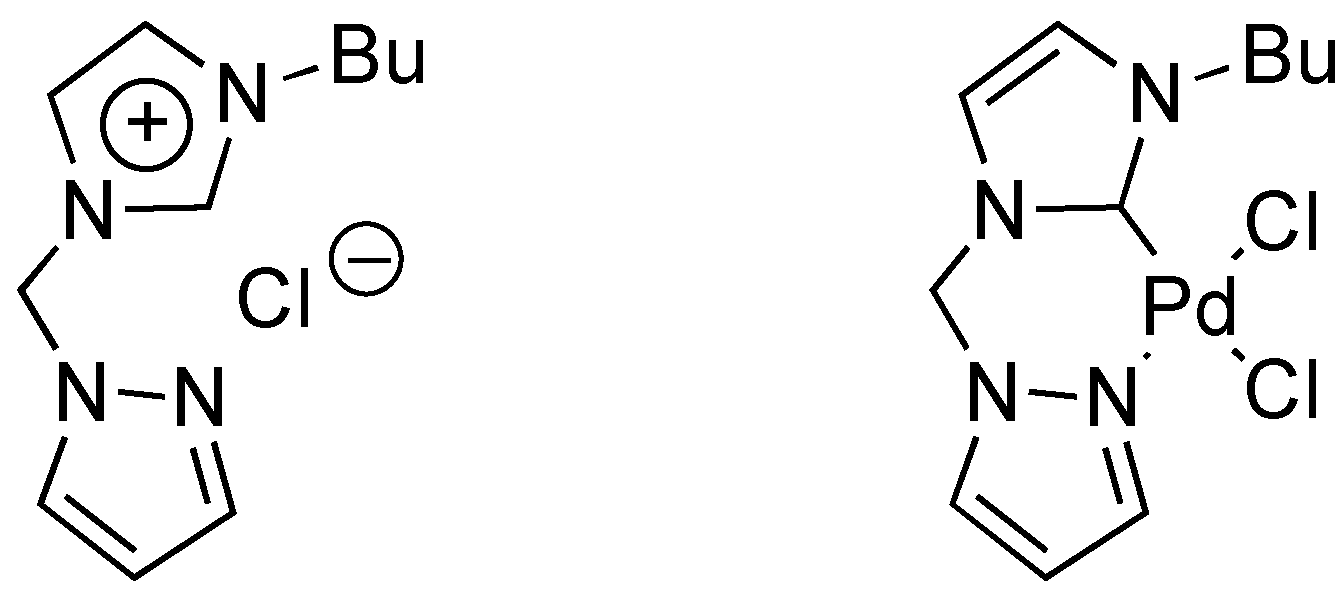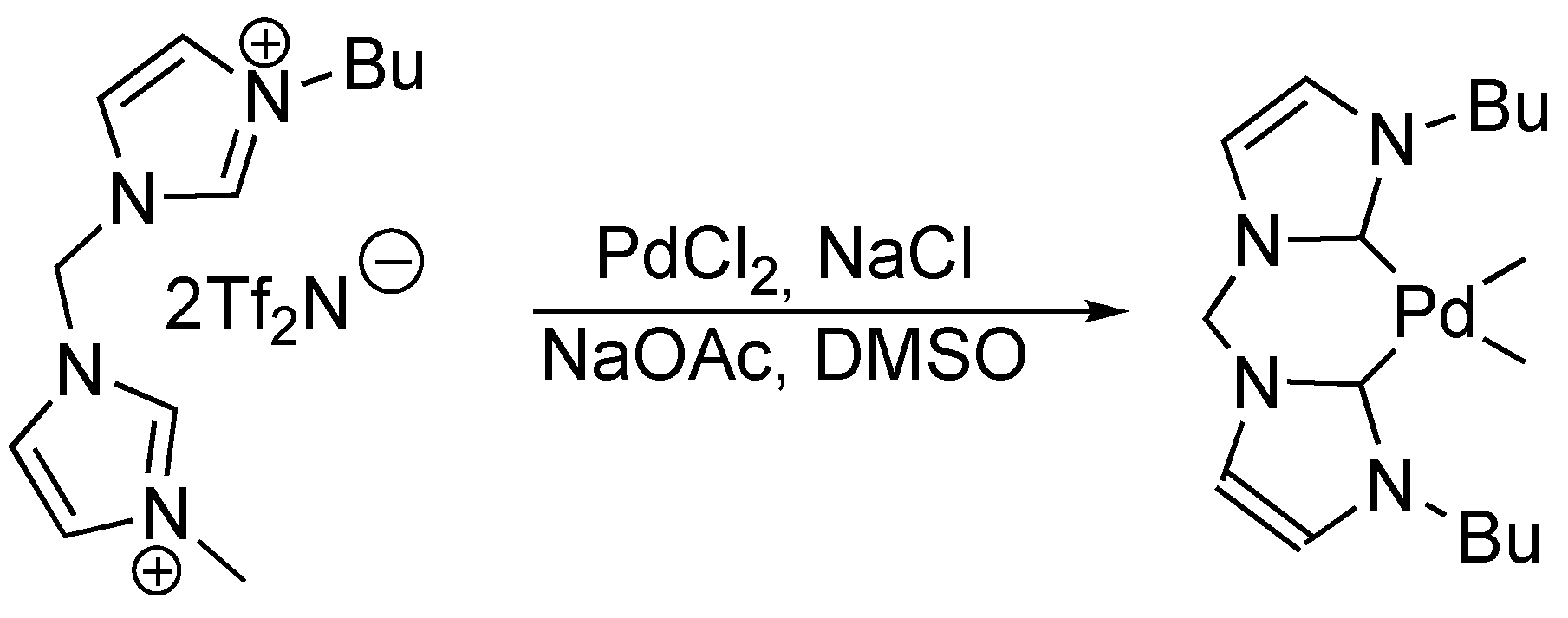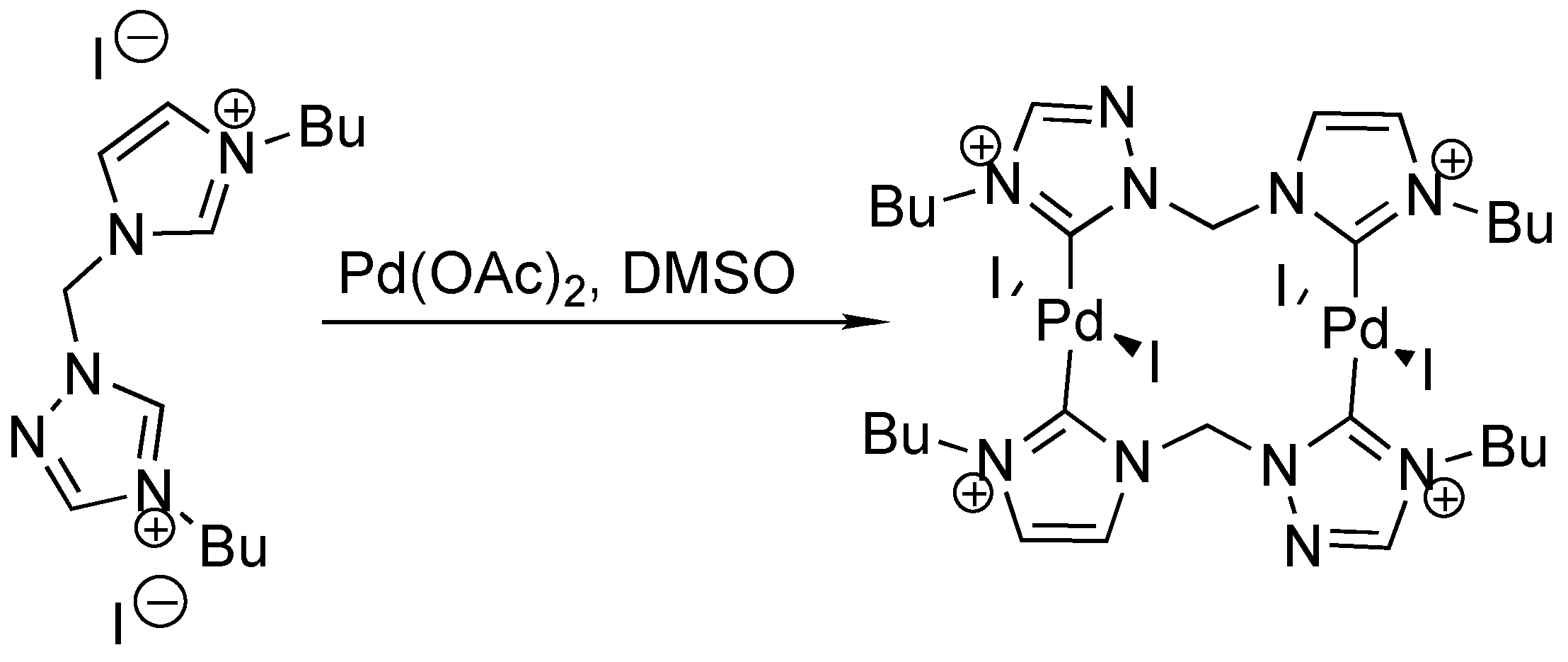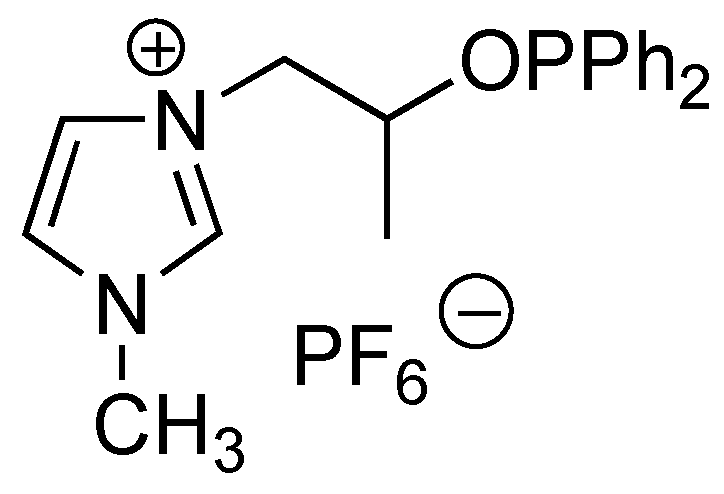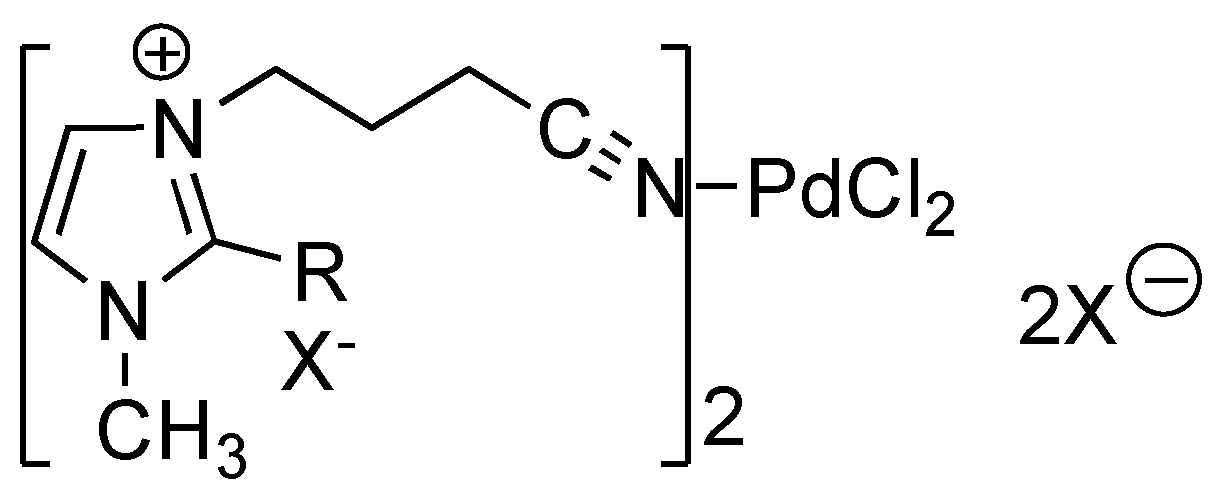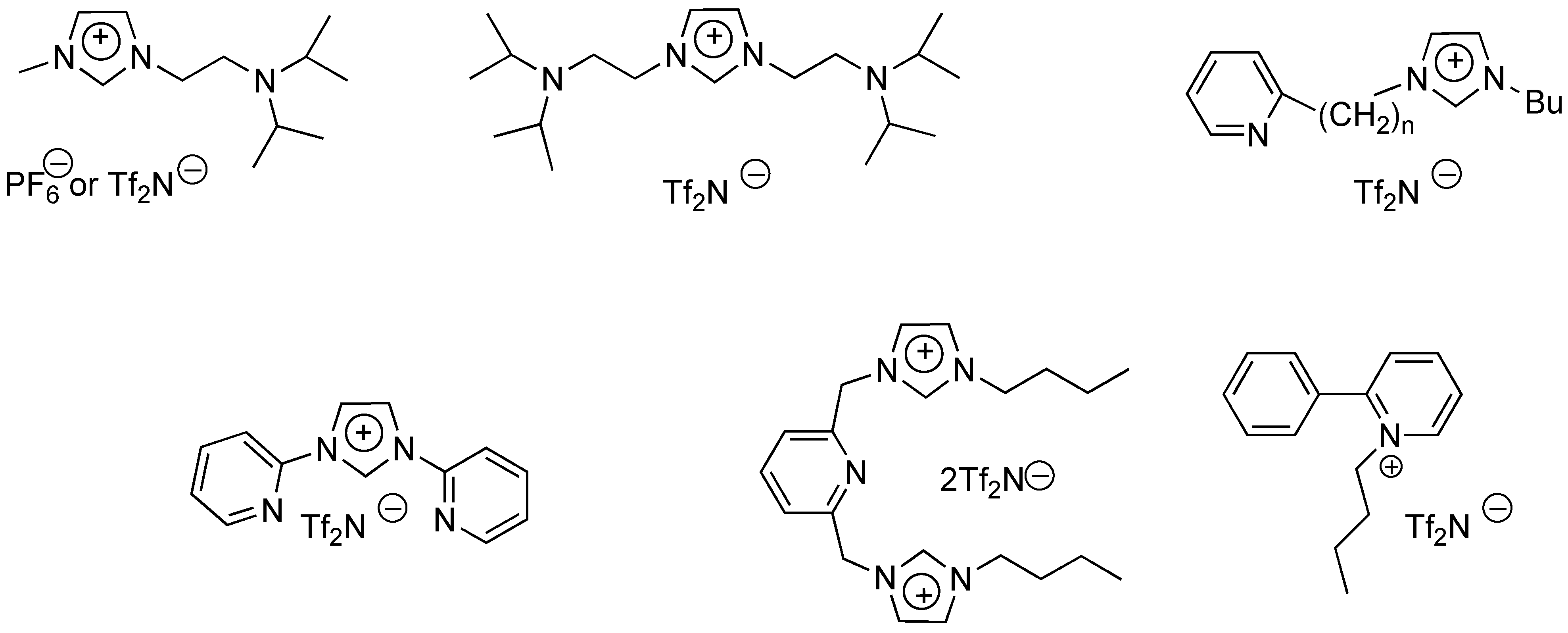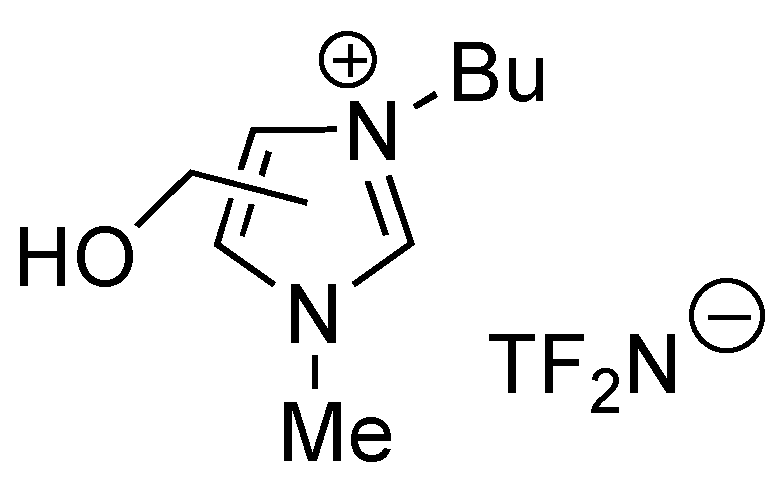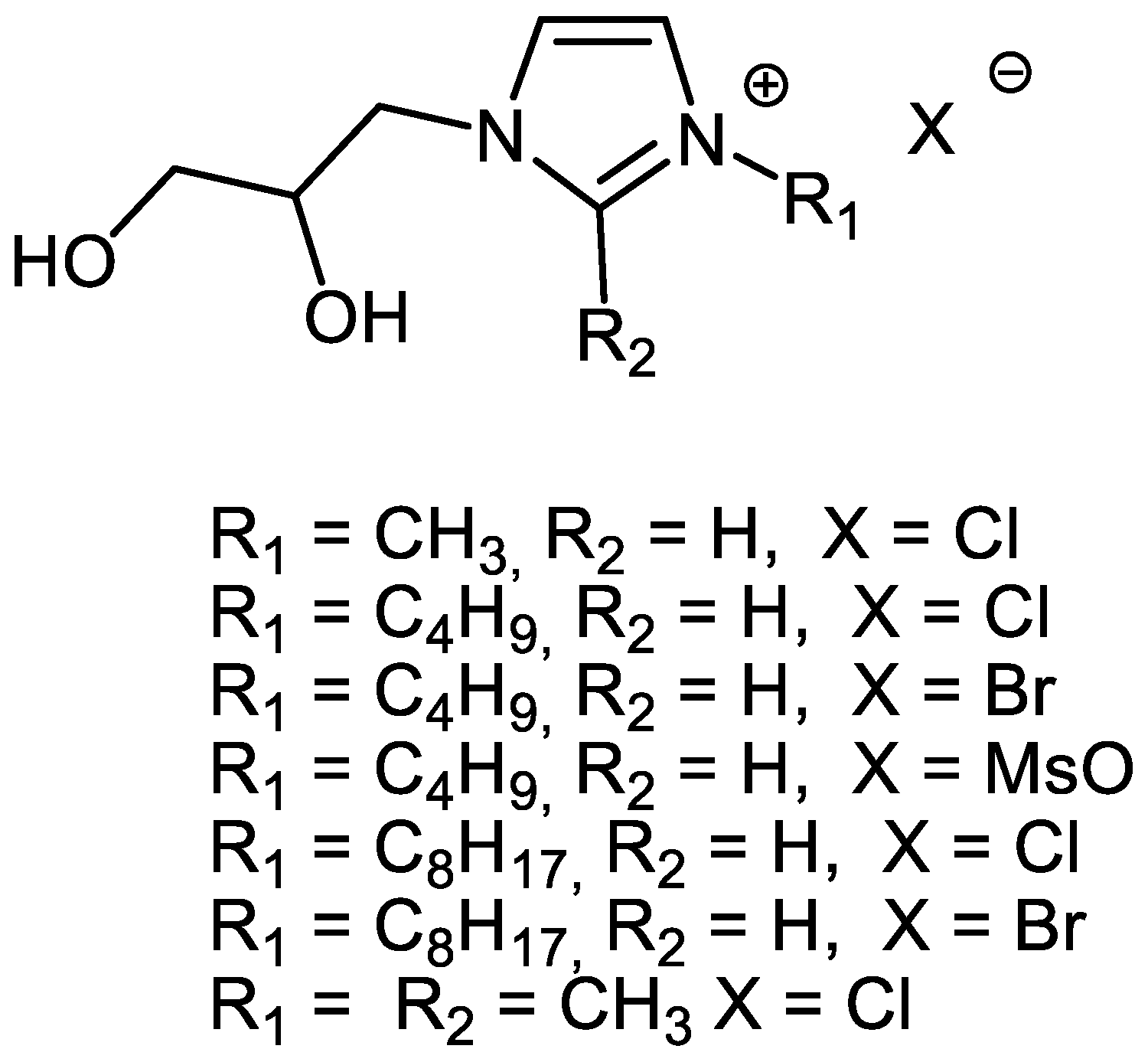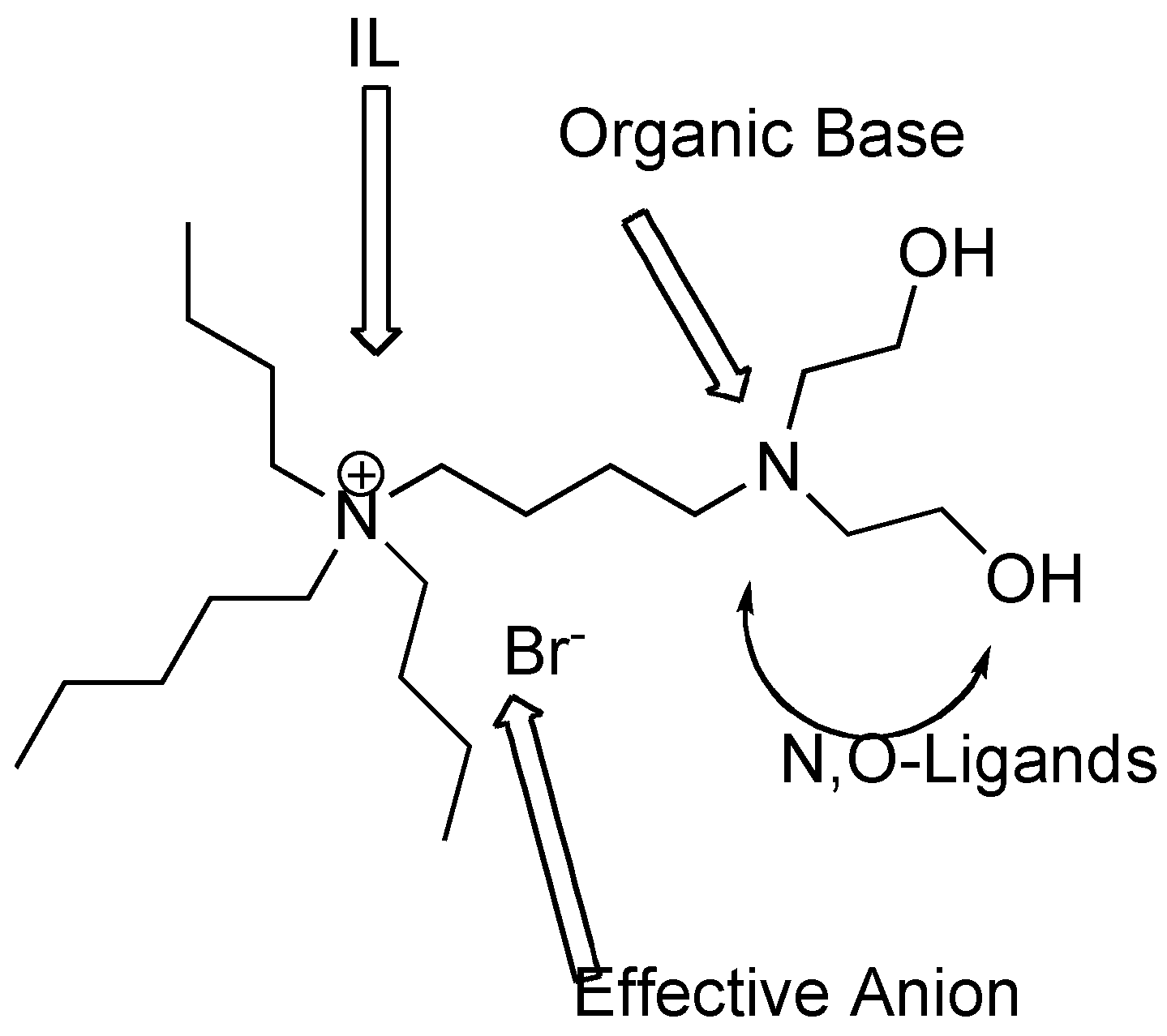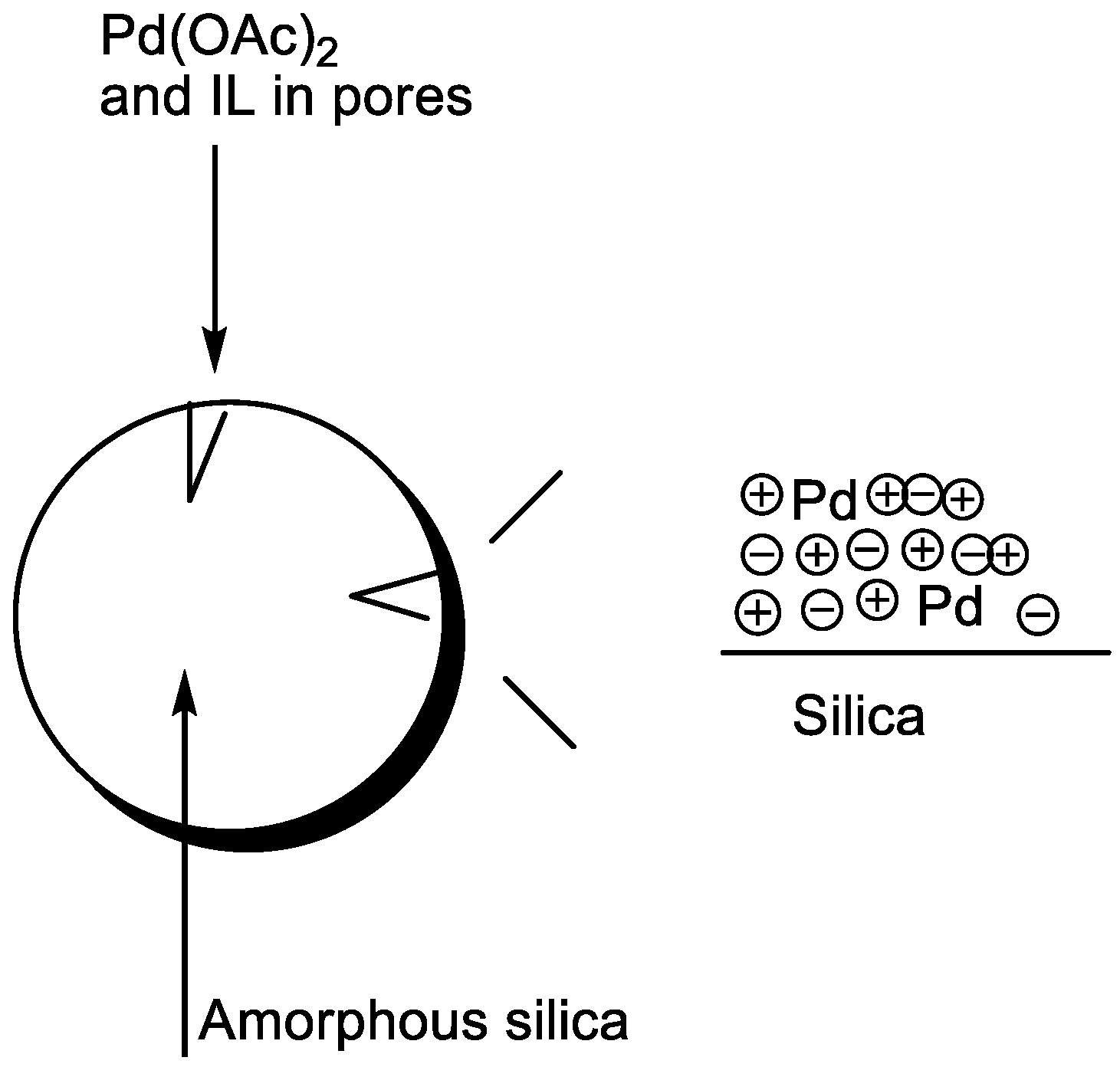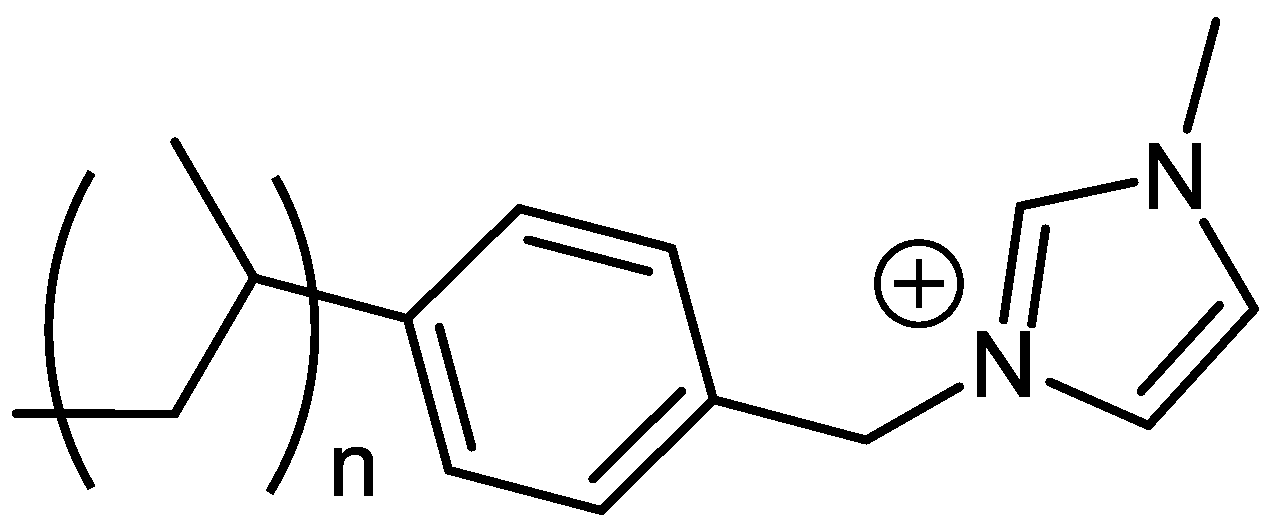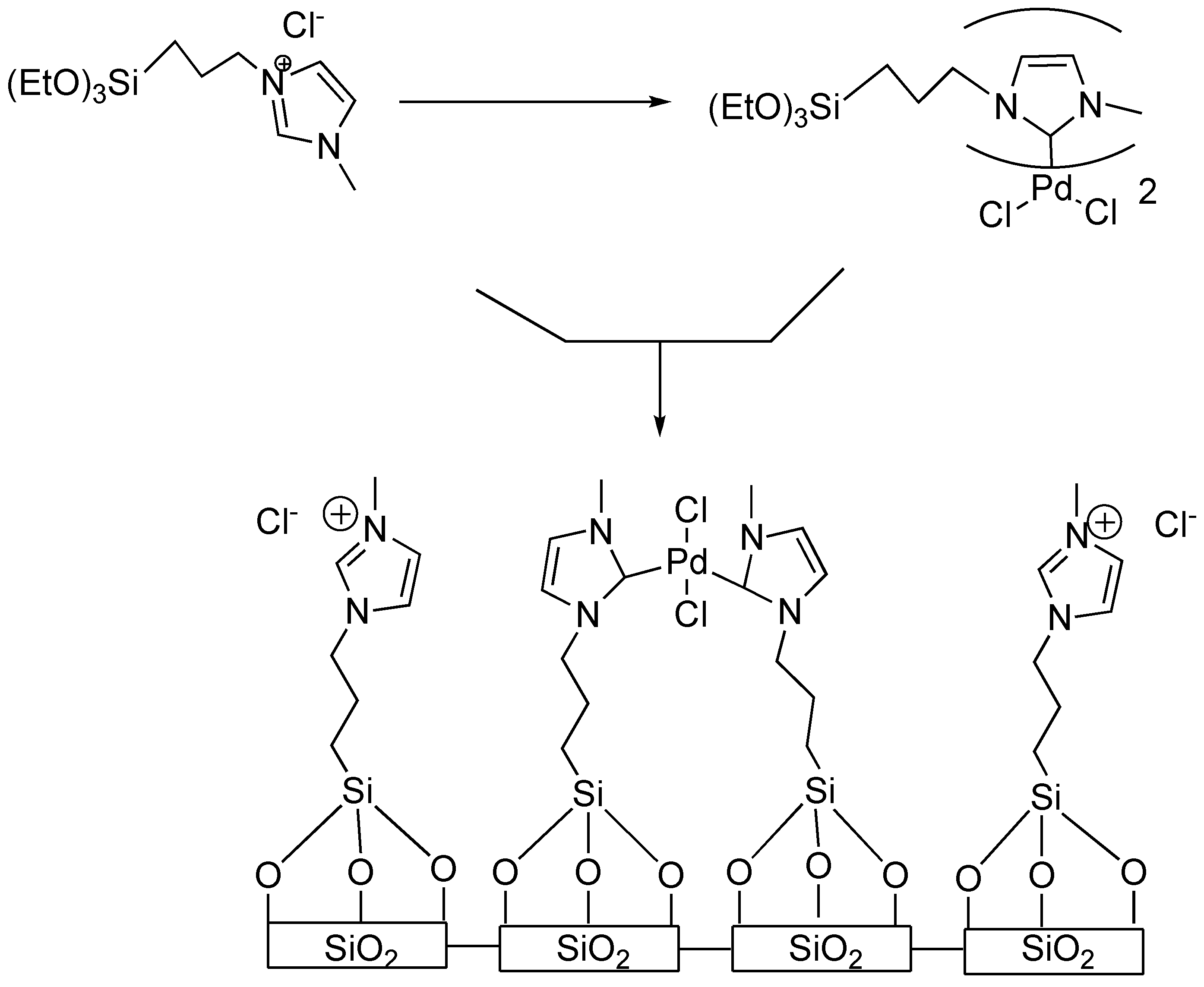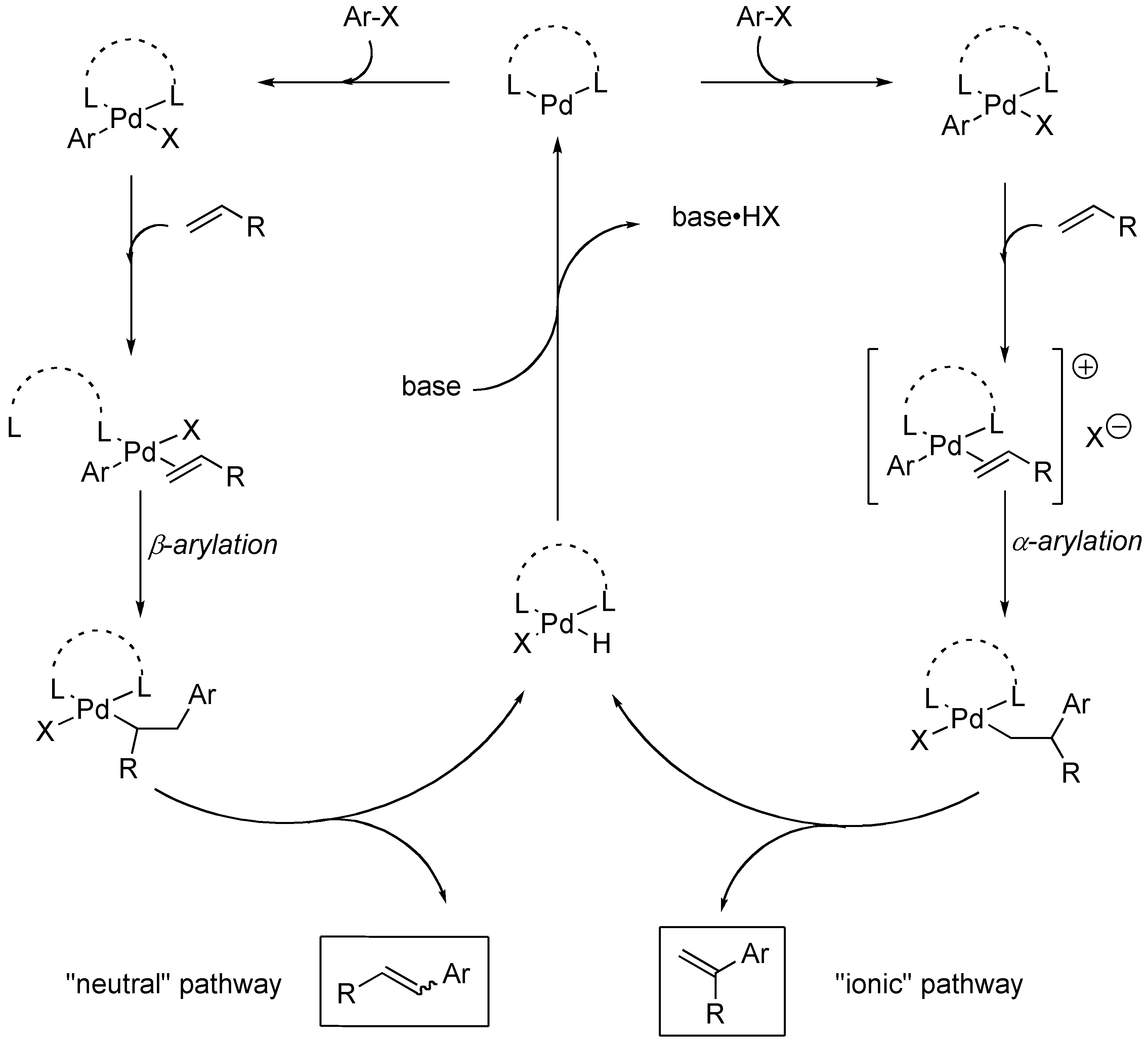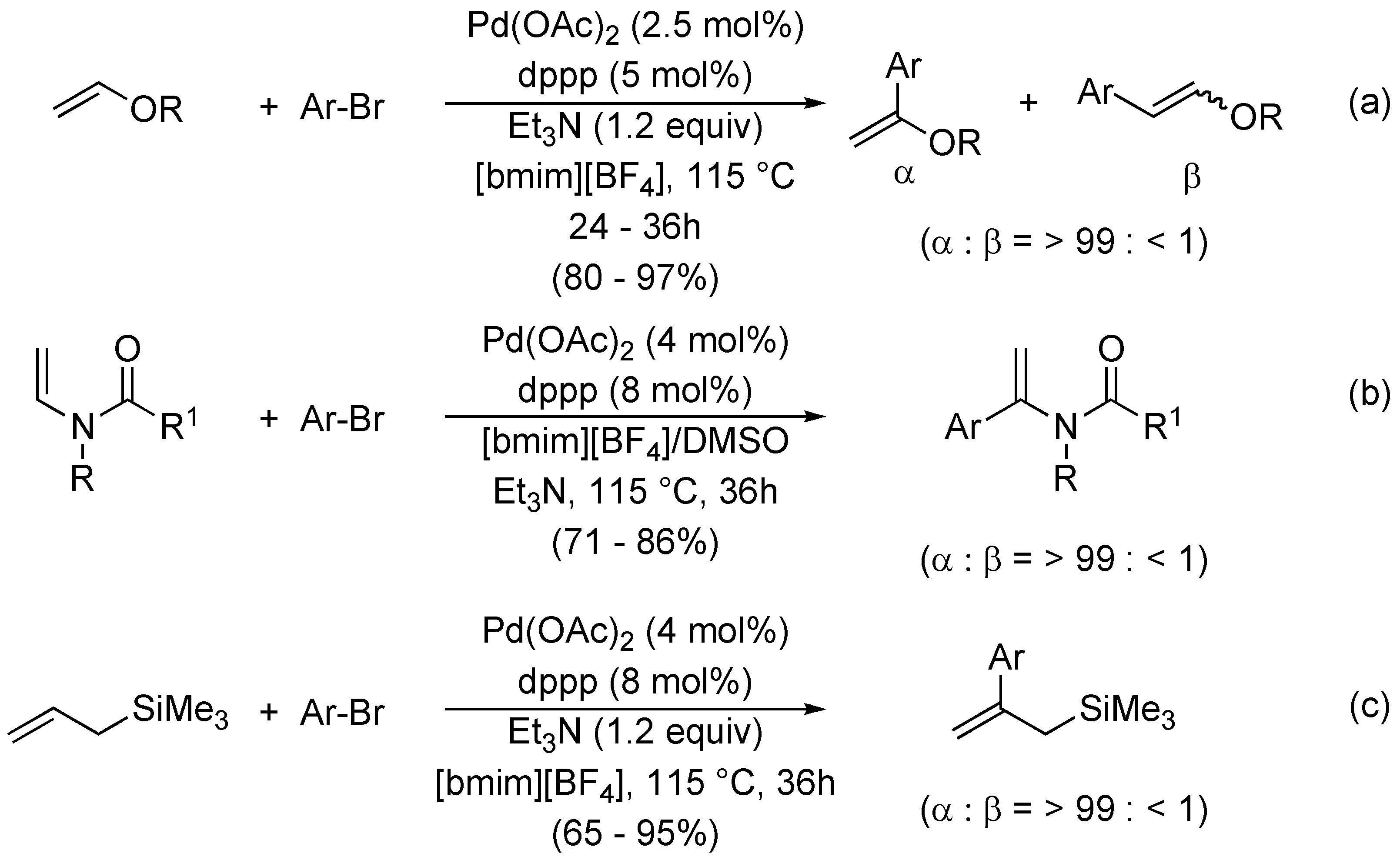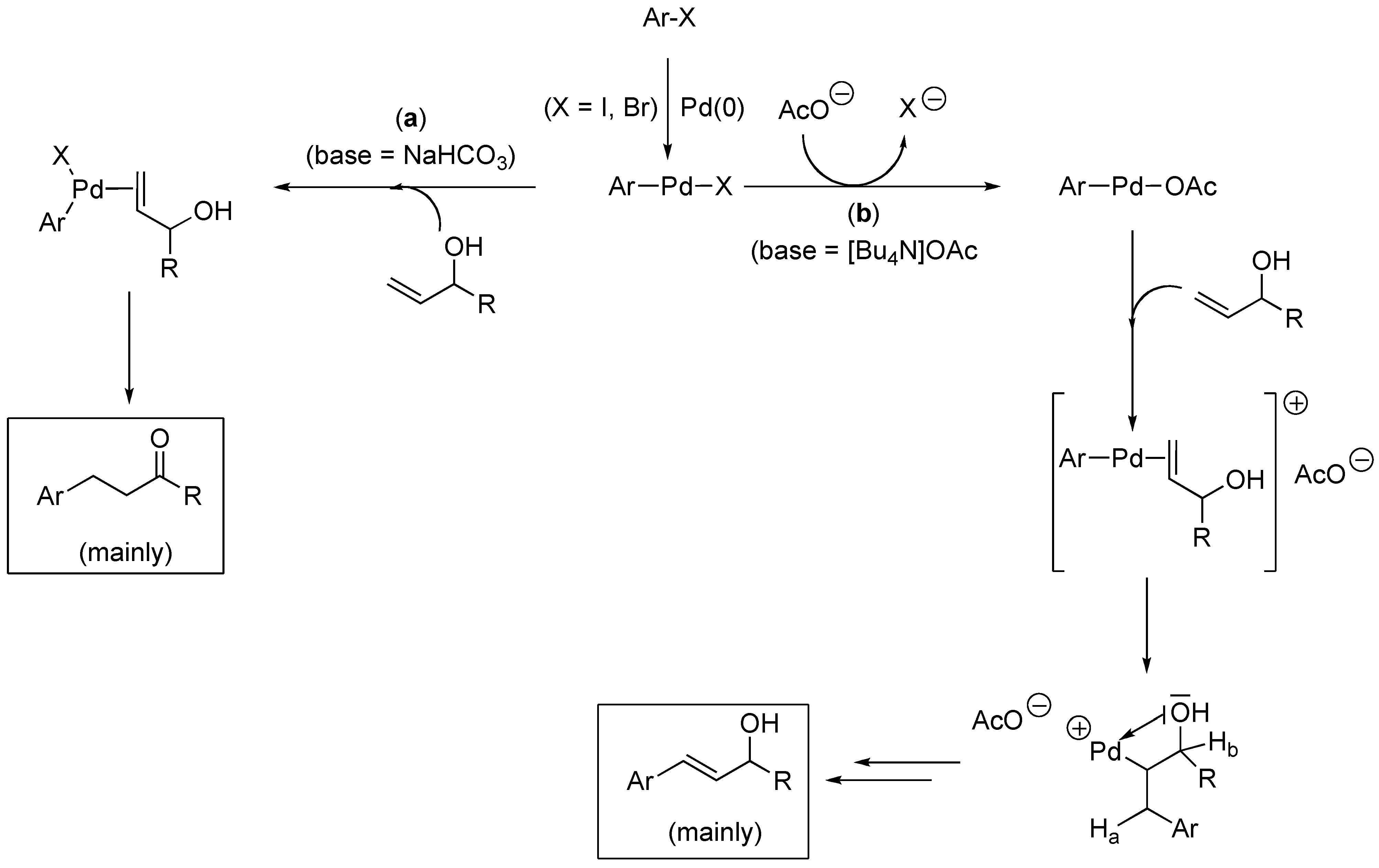2. Heck Reaction in Common ILs
Simple palladium salts such as PdCl
2 or Pd(OAc)
2 in the absence of stabilizing phosphine ligands have been widely used in the Heck reaction in ILs [
10,
11,
12,
13,
14], and preparatively significant examples have been performed.
In 1984, in a pioneering work Jeffery reported the palladium catalyzed vinylation of organic iodides under solid liquids phase transfer conditions, around room temperature, using tetrabutylammonium chloride [
15]. However, the first well-documented application of ILs in the Heck reaction, that is also the first palladium-catalyzed reaction performed in ILs, was reported in 1996 by Kauffmann and co-workers [
16]. In particular, they surprisingly found that Pd(OAc)
2 and PdCl
2 are both appropriate catalyst precursors for Heck reactions without additive ligands (
Scheme 1) in [C
16PBu
3]Br.
The addition of 1.5 equiv. of NaOAc when Pd(OAc)
2 was used as the catalyst precursor, improved the rate of the coupling, but a concomitant decrease of the selectivity was observed, leading to the formation of 5% of the (
Z)-isomer. The precipitation of Pd clusters slowly started after some hours when PdCl
2 was used, but with Pd(OAc)
2 no precipitation was observed. In this last case the catalyst remained in the melt even at complete conversion of the aryl halide, and after the recover of the product by distillation it resulted active in the following two runs. The authors explained these results by supposing that the phosphonium salt exerted an efficient stabilizing effect on the Pd(0) species obtained in situ by reduction of the Pd(II) catalyst precursors. The results reported by the group of Kauffmann attracted the attention of several research groups on the important challenge of developing new protocols for a ligand-free Heck reaction. In fact, ligand-free conditions in metal-mediated reactions should be always preferred, especially on large scale productions, not only for saving the cost of the ligand but also because the purifications are simplified if no ligand is present [
17].
In 1999 the Earle group reported the use of hexylpyridium chloride, [C
6Py]Cl, as solvent in the Heck reaction of iodobenzene with ethyl acrylate using Pd(OAc)
2 as the catalyst precursor and Et
3N or NaHCO
3 as the base (
Scheme 2) [
18].
Interestingly, the use of the corresponding salts containing the non-coordinating anions hexafluorophosphate and tetrafluoroborate required longer reaction times and higher temperature to go to completion (
Table 1).
In contrast to the chloride-based systems, the addition of Ph
3P as ligand also promoted the reaction when an imidazolium-based IL, [bmim][PF
6], was used. The authors explained the experimental results, and in particular the hindering on the efficiency of the reaction of a phosphine, suggesting that in a chloride- (or halide-) reach environment the Heck reaction involves a Pd(II)/Pd(IV) redox cycle, whereas in the case where the phosphine ligand is present a Pd(0)/Pd(II) catalyst is operative. However, today a Pd(II)/Pd(IV) mechanism for the Heck reaction is no more accepted. On the contrary, direct NMR measurements and a great deal of experimental data indicate that the Heck reaction proceeds
via a Pd(0)/Pd(II) catalytic cycle [
19]. It is then plausible that the chloride anion contributes to the dissolution of Pd(0) species which come from the reduction of the Pd(II) precatalyst better than BF
4- or PF
6-.
Related to this work, it must be remarked that benzoic anhydride, in the absence of a base, has been used as a source of the aryl moiety, although higher temperatures and longer times were required to obtain high conversions. The use of hydrophobic ILs gave the possibility to separate products and salt by-products from the catalysts immobilized in IL (for example, in [bmim][PF
6]), simply by extraction with ethyl ether and water, respectively [
18].
Starting from the results reported by Kauffmann, and taking into account the observations made by Jeffery on the activation performed by salt additives and on the ability of stabilizing the catalytically active Pd species [
20], Herrmann and co-workers reported in 1999 their results on ligandless Heck reaction performed in [NBu
4]Br [
21]. As illustrated in
Table 2, where the results of these studies have been summarized, PdCl
2 resulted highly active in promoting the reaction of olefins with iodobenzene (TON = 10000, entry 1), bromoarenes (entries 2-9) and also activated chloroarenes (entries 10–12). However, this catalyst precursor is not capable of coupling 4-chloroanisole efficiently (entry 13).
It is noteworthy that PdCl
2 displayed an increased reactivity in [Bu
4N]Br when compared with DMF, a “classic” solvent for Heck reactions (
Scheme 3).
The unusual long-term thermal stability of the catalyst in [Bu4N]Br most probably accounts to the significant differences observed when the reaction was performed at 150 °C. The catalyst decomposes later in the ammonium salt - if it does at all - than it does in DMF under the same conditions. Indeed, the catalyst seems to be more activated; in fact, PdCl2 runs even about five time faster in [Bu4N]Br than in DMF.
The catalyst and the rather expensive solvent could also be recycled. In fact, in the reaction of bromobenzene and styrene using 1 mol % PdCl
2 and NaOAc as the base the authors were able to recycle the system several times, nevertheless heavy Pd black formation was observed already during the first run, simply distilling off the reactants and the products
in vacuo. It was also possible to filter off the NaBr and the Pd black precipitate after 8 recycling runs by dissolving the mixture in acetone. After evaporation of the acetone the filtrate can be used again and stilbene was obtained in 60% yield [
22].
The high activity displayed by PdCl
2 in [Bu
4N]Br was ultimately attributed by the authors to the thermal reduction of the Pd(II) precatalyst to extremely active colloids. However, it is noteworthy that neither Pd
2(dba)
3 nor preformed Pd colloids resulted to actively promote the Heck reaction in [Bu
4N]Br, confirming that active species have to form
in situ by reduction. The same ammonium salt, in a mixture with [Bu
4N]OAc, was employed three years later by Cacchi and co-workers in an efficient stereoselective synthesis of (
E)- and (
Z)-3,3-diarylacrylates [
23].
In particular, the Pd-catalyzed reaction of neutral, slightly electron-rich and slightly electron-poor aryl iodides with methyl cinnamate in a molten [Bu
4N]OAc/[Bu
4N]Br (2:1.5) mixture provided with high stereoselectivity (
E)-3,3-diarylacrylates (
E/
Z = 98/2 to > 99/1) (
Scheme 4). Phosphine-free Pd(OAc)
2 was employed as the catalyst precursor.
Moreover, the reaction of a variety of methyl 3-arylacrylates with iodobenzene under the same reaction conditions afforded selectively the corresponding (
Z)-isomers (
E/
Z = 4/96 to <1/>99) (
Scheme 5). It was also observed that the catalyst system might be recycled without any loss of activity.
The authors, in order to justify the observed elevated stereoselectivity, attributed to the acetate anion a key role; in particular, they supposed that this anion could favour the irreversible displacement of Pd from σ−Pd adducts thus suppressing any possible isomerization mechanism. They also attributed the high reactivity of Pd(OAc)2 in the used molten salt mixture to the formation of palladium nanoparticles stabilized by the ammonium salts.
A similar stabilization of the active Pd catalytic species was invoked by Muzart and co-workers, who employed NaHCO
3 as the base and PdCl
2 as the catalyst precursor in a Heck arylation of allylic alcohols in [Bu
4N]Br, affording β-arylated carbonyl compounds (
Scheme 6) [
24].
This protocol, which let possible to recycle the active catalyst up to four times, was also applied to a one-step synthesis of the nonsteroidal antiinflammatory drug nabumethone (
Scheme 7) [
24].
During the past decade, in a series of important papers [
25,
26,
27] Calo`
et al. have evidenced the superiority of tetraalkylammonium halides over common pyridinium and imidazolium salts in terms of catalysts stability, reaction rates and regio- and stereoselectivity in Pd nanoparticles catalyzed coupling reactions. Bromoarenes were coupled with less reactive 1,2-disubstituted alkenes, such as
trans-cinnamates, in a stereospecific manner under ligand-free conditions in 1:1.5 molar mixtures of tetrabutylammonium bromide and tetrabutylammonium acetate, TBAB-TBAA (
Scheme 8) [
26]. The observed stereoselectivity was ascribed not only to a better solubility of TBAA in TBAB, but also to an intramolecular neutralization of PdH, still ligated to the olefin, by an acetate ion in the metal coordination shell through a five-membered transition state.
The absence of acetate in the coordination shell would allow the PdH isomerization, leading to a thermodynamic mixture of isomeric olefins. This palladium nanoparticles-catalyzed Heck arylation was extended to butyl methacrylate and α-methylstyrene. In this case, however, a 3:1 mixture of regioisomers was obtained in favour of the terminal olefins, together with variable amounts of double-arylated products [
27].
In this contest, recently Nacci
et al. have recently reported [
28] a general method for coupling of aryl chlorides, including deactivated and electron-rich aryl chlorides, using ligand-free Pd(OAc)
2 in the molten mixture of tetraalkylammonium ionic liquids (TBAB-TBAA) under aerobic and relatively mild conditions (
Scheme 9). Interestingly, using this system it was possible to couple 1-bromo-4-chlorobenzene with two different olefins in a one-pot sequential manner by activating the C-Br and C-Cl bonds on the aromatic ring at two different temperatures of 100 and 120 °C. Unsymmetrical substituted arenes were produced with high reaction rates and high overall yield.
An extensive investigation on Pd-catalyzed Heck reactions in imidazolium based ILs has been performed by the research group of Xiao. In 2000, they published [
29] a detailed study on reaction of iodobenzene with styrene and acrylates catalyzed by Pd(OAc)
2, showing for the first time that the imidazolium cation can react with a catalyst precursor to form
N-heterocyclic carbene complexes
via deprotonation in the imidazolium-based ionic liquids under catalytic conditions, and that the carbene complexes so generated are active for C-C bond coupling reactions. Subsequently, they focused on the palladium catalyzed arylation of the electron-rich olefins, such as butyl vinyl ether in [bmim][BF
4], using aryl iodides and bromides as the arylating agents. The results of these studies, reviewed in 2008 [
30], showed that imidazolium ILs in combination with the readily available Pd(OAc)
2 and 1,3-bis-(diphenylphosphino)propane (DPPP) form an excellent catalytic system, in which highly regioselective and yielding arylation of electron reach olefins can be performed with a wide range of aryl halides with no need for any halide scavengers (
Scheme 10).
Generally, the arylation gives only the branched olefins; the unique stereocontrol has been attributed to the ionic environment, which alters the reaction mechanism favoring the ionic pathway. It is however noteworthy that for this kind of reactions little conversions (<1%) were observed [
31] in [bmim]Br and [bmim]Cl and these results were attributed to the coordination of halides with palladium and/or the formation of inactive imidazolium carbene complexes of Pd. The inhibitory effect of bromide on this reaction has been subsequently more extensively investigated [
32] by the same authors, who on the basis of the dramatic decreases in the arylation rate with increasing bromide concentration, hypothesized the presence of an equilibrium (eq. 1) before the rate determining step.
HBr, generated from each arylation, must be effectively scavengered by the NEt3, which may be able to trap also the bromide anions by hydrogen bonding between [HNEt3]+ and Br-. A remarkable accelerating effect exerted by the potential hydrogen bond donor [HNEt3]+ was evidenced in the same paper.
In conclusion, whereas halides ([NBu4]Cl) are able to accelerate the Heck reaction employing palladium catalysts containing monodentate olefins or no ligands, they have an inhibitory effect on Pd-dppp catalyzed reactions. To a different mechanism, molecular in the first case and ionic in the second one, was attributed the different behavior (for a detailed discussion see below).
Despite of the extensive work performed on Heck reactions in the last ten years, it is however noteworthy that only few data have been reported on the intramolecular process. The sole paper on this topic evidenced that substituted benzofurans can be obtained [
33] in modest to good yields by palladium-catalysed intramolecular Heck reaction in [bmim][BF
4] (
Scheme 11). In general, the yields of the substrates with a substituent on the aryl group were lower, although the character of the substituent was not able to affect significantly the reaction yield. The catalyst in the IL phase could be re-used by the addition of another portion of substrate, Bu
3N and HCO
2NH
4; the catalytic activity varied from 71 to 57% after four cycles.
Finally, it must be remarked that although generally aryl halides have been used in most of the investigated reaction in ILs, in 2004 Kabalka
et al. reported [
34] the palladium catalysed reaction of methyl acrylate and methyl acrylonitrile with arenediazonium salts in [bmim][PF
6]. The reactions could be performed at room temperature for methyl acrylate and at 50 °C for acrylonitrile in the absence of base and in relatively short reaction times (
Scheme 12). The catalytic system was recycled at least four times without loss of activity, although electron-rich olefins did not react and styrenes produced dimerisation products.
3. Task-Specific Ionic Liquids (TSILs) in the Heck Reaction
On the base of the data reported in the previous section it is possible to conclude that the Heck reaction based on the use of ILs is clearly advantageous from the point of view of product separation and re-use of the catalytic system. In addition, most of the reactions can be performed in the absence of added phosphorous containing ligands and, selecting ionic liquid and reaction conditions, it is possible to use also aryl bromides and chlorides or benzoic anhydrides. However, common ILs still have a tendency to leach dissolved catalysts into the co-solvent used to extract the product(s). To avoid metal catalysts leaching out of the IL system, significant efforts have been made to enhance the solubility of the catalysts in ILs and practically two approaches have been followed: i) functional groups able to coordinate with metal centers have been inserted into the ILs, ii) imidazolium/pyridinium tags have been introduced into a metal complex.
In this context, in 2004 Shreeve
et al. reported [
35] the synthesis of the monoquaternary product arising from the reaction of 2,2’-diimidazole with iodobutane and the application of the obtained IL as solvent and ligand for the Heck reaction. The new palladium complex, reported in
Scheme 13, was isolated by adding PdCl
2 to this ionic liquid in methanol. The same 2-imidazole functionalized IL was used for the Heck coupling of iodobenzene with methyl acrylate in the presence of PdCl
2 (2 mol%) and a Na
2CO
3 as a base. After product recovery (92% yield) the system was washed with water and re-used another four times without significant activity loss. The recovered system was used also with the non-reactive chlorobenzene, leading to the same product in 74% yield after two runs.
An analogous functionalized palladium(II) complex was obtained by reaction 1-butyl-2-(2-pyridyl)-3-methylimidazolium bistriflimide with PdCl
2 in methanol. The coupling reaction of iodobenzene with butyl acrylate in the corresponding IL, 1-butyl-2-(2-pyridyl)-3-methylimidazolium bistriflimide, or in the analogous 1-butyl-2-(phenyl)-3-methylimidazolium bistriflimide could be performed successfully 10 times without detectable loss of catalytic activity (
Scheme 14).
However, when the Heck reaction was carried out using PdCl2 under similar conditions, the formation of palladium black was evidenced and after two cycles the system became practically inactive. Moreover, whereas no appreciable difference in yields between activated and deactivated aryl iodides was found, the electronic nature of aryl bromides had a clear effect on the coupling reaction.
But the functionalization of the imidazolium ring not necessarily have to involve the C(2) imidazolium carbon. Substituents able to interact with palladium(II) have been introduced also on the imidazolium nitrogen. Pyrazolyl-functionalized 2-methylimidazolium based ILs have been therefore synthesized and the activity and recyclability of the palladium complexes have been evaluated [
36] (
Figure 1).
Initially, the Heck reaction was performed using as catalyst the functionalized palladium complex dissolved in the pyrazolyl-functionalized IL. However, interestingly, this catalyst could be used also in a unfunctionalized IL (1-butyl-2,3-dimethylimidazolium bistriflimide) obtaining at the 9th recycle a complete conversion of iodobenzene. The efficiency of the process was attributed to the presence on the catalyst of a pendant 2-methylimidazolium tag which is similar to the unfunctionalized IL and favour immobilization. Of course, when the Heck reaction was examined using PdCl2 as the catalyst precursor in the pyrazolyl-functionalyzed IL under identical conditions similar results were obtained. In this reaction, reactivity decreased using bromobenzenes whereas only traces of the product were obtained with 4-chlorobenzene.
Starting from N-alkylimidazoles another series of pyrazolyl-functionalized imidazolium based ILs was subsequently synthesized and characterized [
37]. Through a (carbene)silver complex, a palladium complex was prepared, isolated and characterized. In this case, as a consequence of the absence of the methyl group at C(2) on imidazolium ring, the functionalized IL acted as a chelating ligand coordinating the palladium(II) center through its carbene carbon atom and the pyrazolyl nitrogen atom to give a six-membered metallacycle with boat-like conformation (
Figure 2).
The catalytic activity as a pre-catalyst was investigated in the corresponding IL using the above reported procedure. Aryl halides gave with butyl acrylate the expected product in > 90 % yield independently of the substituents on the phenyl ring. No detectable loss of catalytic activity was observed after five recycles. Contemporaneously, also the activity of a hemilabile pyrazolyl-functionalized N-heterocyclic carbene complex of Pd(II) in [bmim][PF
6] was evaluated by the same group [
38]. The catalyst could be recovered and recycled at least three times without significant loss of activity (
Figure 3).
On the other hand, considering that some chelate or pincer N-heterocyclic Pd-carbene complexes exhibit high catalytic activity for Heck reactions [
39], the application of an IL containing a pincer dication substituted with two alkyl chains has been investigated in the Heck reaction of aryl halides with butyl acrylate at 120 °C [
40] by Shreeve
et al. (
Scheme 15). Iodobenzene was found to have the highest reactivity, giving
trans-butylcinnamate in 92% yield using both PdCl
2 or the isolated palladium complex as catalyst and NaOAc as base, whereas bromobenzene resulted in 71% yield and chlorobenzene was practically unreactive (3% yield). In this case, the recovered IL could be reused three-times without significant loss of activity.
Since the introduction of a third nitrogen atom on the five member heteroaromatic system could increase the acidity of the C-2 position favoring Pd-carbene complex formation, unsymmetrical dicationic salts incorporating imidazolium and triazolium functionalities were also synthesized and tested [
41].
It is noteworthy that, instead of a chelating palladium(II) dicarbene complex, the reaction with Pd(OAc)
2 in DMSO gave a dinuclear complex, which analogously to the above reported complexes could be used as pre-catalyst in the Heck reaction (
Scheme 16). Comparable results were obtained using the same procedure.
Contemporaneously, the strategy to introduce specific functional groups on the alkyl chain of imidazolium cation to increase the catalyst immobilization has been followed by other research groups.
In this contest, it has been shown [
42] that the use of an imidazolium based phosphinite IL (
Figure 4) as solvent and as ligand in the coupling reaction of aryl halides (including chlorobenzene) with styrene and butyl acrylate allows the synthesis of the expected product in high yield (generally, around 90% also for ArCl) assuring also a high recyclability (six runs without losing its efficiency). Although the crystal structure of the catalyst was not reported, the formation of a carbene-type complex was excluded on the basis of the
1H NMR spectrum, and a ML2 complex was hypothesized.
Significant results have been obtained also by Dyson
et al. introducing a nitrile group on the alkyl chain(s) of pyridinium and imidazolium based-ILs (
Figure 5) [
43,
44,
45].
Nitrile-functionalized ILs have been used with success in several palladium catalyzed reactions, including the Heck process and their usefulness became apparent upon catalyst recycling; while in conventional ILs activity rapidly decreased to zero, in nitrile-functionalized ILs little change was observed after several recycles. Functionalization of the alkyl chain facilitates the solubility of the Pd(II) precatalyst
via weak coordination of the nitrile groups to the palladium center, as evidenced through IR measurements (
Figure 6). Moreover, when palladium nanoparticles are involved nitrile group may form a protective sheath around the nanoparticles, preventing aggregation.
It is noteworthy that, at variance with other palladium catalyzed reactions, reuse of the IL system in the Heck reaction was not very encouraging, due to observed progressive loss of activity. The decrease in reactivity of the catalyst could be however ascribed to the consumption of the base; the addition of 1 equiv of cholinium acetate after the fourth cycle restored the reactivity of the system.
To overcome the problems arising from the depletion of the base during the recycles, more recently basic IL have been employed as both solvents and proton scavenger in Heck coupling reactions. The first example, reported [
46] by Shreeve
et al., evidenced that IL bearing tertiary aliphatic amines are effective media for the Heck reactions (
Figure 7).
Under reflux conditions, iodobenzene reacted with butyl acrylate to give the cinnamic ester in 100% yield. The catalytic system could be reused simply by washing with NaHCO3; after five recycles no activity loss was observed. Also in this case the formation of palladium nanoparticles was observed; all attempts to synthesize carbene-palladium complexes resulted in stable palladium colloids. The hypothesis that the tertiary amine might act as reducing agents in the redox process, leading to the formation of nanoparticles, was advanced.
Subsequently, 1,4-diazabicyclo[2,2,2]octane (dabco)-based ILs (
Figure 8) having as counteranion the basic dicyanamide or tetrafluoroborate have also been tested in the Heck reaction [
47]. Although after two hours the yields of the recovered product for the model reaction (iodobenzene-ethyl acrylate) were lower than in the comparative reaction performed in [bmim][BF
4], the dabco-based ILs could be reused without re-addition of base and reducing agent.
Finally, also hydroxyl or diol functionalized ILs (
Figure 9) have been employed has reaction media and catalyst ligands in the Heck reaction. In 2003, Handy
et al. prepared a new class of hydroxymethyl substituted imidazolium based ILs using fructose as the starting material [
48].
The ionic liquid having bistriflimide as counteranion was employed as solvent for the model Heck reactions of methyl acrylate with simple aryl iodides in the presence of Pd(OAc)2. The coupling products were isolated in almost quantitative yields simply by extracting the crude mixtures with cyclohexane. Moreover, the solvent and catalyst were recycled 4-5 times without affecting the efficiency of the reaction. Also in this medium, however, the Heck coupling was slower than those performed in the standard, non-protic [bmim] series ionic liquids, although not at a great extent. An interesting accelerating effect of catalytic amounts of certain halide ions on the coupling of iodobenzene and methyl acrylate was observed.
More recently, a series of imidazolium based ILs N-functionalized with a 2,3-dihydroxypropyl group (
Figure 10) has been used as ligands and solvents for palladium(II)-catalyzed reactions; these compounds present, besides the N-heterocyclic donor moiety arising from the imidazolium skeleton, the ethylene glycol group able to act as an excellent chelating ligand [
49].
The Heck coupling of iodobenzene and ethyl acrylate in glycerylimidazolium-based ionic liquids at 100 °C has been performed in the presence of 5 mol-% PdCl
2 as the catalyst precursor and AcONa (1.1 equiv) as the base. Although reuse of the IL systems was not very encouraging, due to the progressive loss of activity, a high reaction rate was observed in particular in 1-glycerol-3-octylimidazolium chloride, [GLYOCTIM]Cl. The reaction yields increased on increasing the alkyl chain on cation ([GLYOCTIM]Cl > [GLYBIM]Cl > [GLYMIM]Cl, and [GLYOCTIM]Br > [GLYBIM]Br) and were affected by anion nature and by the presence of a methyl group at C(2). The very low yield obtained by using 1,2-dimethyl-3-glycerylimidazolium chloride as solvent suggested that imidazolium carbenes, formed by reaction of the base with the acidic C(2)-H bond of the [GLYIM
+] cations, might be actively implicated in these reactions (
vide infra). Since the formation of carbenes in imidazolium-based ILs should be favoured by the basicity of the counteranion [
50], the involvement of these species is also in agreement with the anion effect: bromides give lower conversions than chlorides and practically no reaction was observed in [GLYBIM]OMs.
Finally, 1-glycerol-3-methylimidazolium hexafluorophosphate has been successfully used [
51,
52] also as the active and recyclable catalytic system in the reaction of aryl bromides with methyl ethyl acrylate under aerobic condition in DMF.
Recently, a novel IL able to act as base, ligand and activator (
Figure 11) has been synthesized by Wang
et al. [
53] The olefination process of alkenes (styrene, acrylates and acrylonitrile) with activated and deactivated iodo, bromo and chloroarenes has generated the corresponding products in good to excellent yields in 4-(dihydroxyethyl)aminobutylammonium bromide). Transmission electron microscopy (TEM) has evidenced the formation of particles having an average diameter of
ca. 4 nm suggesting that the ethanolamine functionalized IL are able to stabilize palladium colloids. It is noteworthy that the system is characterized by a high recyclability; palladium and IL were recycled six times with no loss of their activity and the inductively coupled plasma (ICP) analyses of the extracted organic solvents indicated that Pd content was < 0.2 ppm.
An alternative approach to the use of multifunctionalized ILs may be the use of mixtures of differently substituted ILs which can exert the functions of ligand, base and reaction medium as one unit. In this contest, the ternary mixture of 1-butyl-2-diphenylphosphino-3-methylimidazolium hexafluorophosphate, [bdppmim][PF
6], 1-(2-piperid-1-yl-ethyl)-3-methylimidazolium hexafluorophosphate, [pemim]PF
6] and 1-butyl-3-methylimidazolium hexafluorophosphate, [bmim][PF
6] represents an efficient and recyclable system for the PdCl
2 catalyzed coupling of aryl halides (including hindered and electron-rich aryl iodide and activated aryl bromides) with ethyl acrylate (
Figure 12) [
54].
Experiments performed using the single ILs or their binary mixtures evidence a synergistic effect when used as one unit: due to the presence of more coordinating sites the palladium catalyst combined the advantageous activity and stability of N,P-containing ligand coordinated Pd complexes and Pd-carbene complexes, although the exact nature of the species present in solution was unknown. Furthermore, the strong hydrophobicity of the resulting system allowed the recovery of [pemim][PF6] during the washing phase between two subsequent cycles and the recycling uses of palladium catalyst.
More recently, the catalytic activity of 1-butyl-2-diphenylphosphino-3-methylimidazolium hexafluorophosphate, [bdppmim][PF
6], or 1-(2-piperid-1-yl-ethyl)-3-methylimidazolium hexafluorophosphate, [pemim][PF
6] in the model Heck reaction of aryl halides with methyl or ethyl acrylates in [bmim][PF
6] has been compared [
55] with that of a hybrid P,N ligand functionalized IL, 1-(2-piperid-1-yl-ethyl)-2-diphenylphosphino-3-methylimidazolium hexafluorophosphate, [pedppmim][PF
6], combining the structural peculiarities of the other two ligands in a sole molecule. In this case an organic base was always added.
With the involvement of the hybrid P,N-ligand, PdCl2 exhibited a very good activity and stability also after seven runs without any precipitation of black palladium. In each run pure ethyl cinnamate was obtained in >96% yield, whereas the ICP analysis indicated that leaching of Pd in the organic phase was below the detection limit (< 0.1 mg/g). When the sole P-containing ligand was used lower yields were obtained although good stability was observed. At variance, in the N-containing ligand the palladium catalyst deactivated gradually during the recycle procedure with the obvious precipitation of Pd black, though its fresh activity was better than the corresponding hybrid P,N-ligand. Therefore, as suggested by the authors, the results seem to show that as a bidentate ligand, the P,N-functionalized IL, with a hemilabile ligation to metal center could offer the necessary insaturation site for the substrate (at N-coordinating site) simultaneously holding the Pd by the P-ligand arm. Moreover, the bonding of the phosphine moiety to C-2 position of the imidazolium, having an electron-withdrawing nature, results in a decreased electron density at the phosphorous center, leading to an improved oxidation tolerance of its self with consequent stability of the catalyst. This feature was evidenced also for the P-containing ligand in the above discussed ternary mixture.
Finally, although many of the works on Heck reaction are related to imidazolium based ILs, in 2006 an interesting paper highlighting the possibility to the use of a Brønsted guanidine acid-base ionic liquid as media and catalyst was published (
Figure 14) [
56].
The basic butyltetramethylguanidinium acetate, prepared by neutralization of the corresponding guanidine with acetic acid, was used successful as solvent, ligand and base in the reactions of aryl halides with styrene and butyl acrylate at 140 °C. High yields of the expected products were obtained in subsequent runs (the system was reused five times) until all acetate was converted to bromide. Determination of the palladium that remained in IL evidenced only a slight decrease. It is noteworthy that quantitative conversion was achieved within 0.25 h when 0.16 mol % of PdCl2 was used; decreasing the catalyst loading to 0.01% still resulted in quantitative conversion although the reaction time was prolonged at 20 h.
Considering that at elevated temperature the guanidinium based IL may dissociate into guanidine and acetic acid, the author suggested that the generated guanidine acts as a base and a ligand for active Pd species. The molecular structure of the corresponding L
2PdCl
2 complex was reported (
Figure 15) and its activity as catalyst for the reaction between bromobenzene and styrene was tested in DMA.
In conclusion, this simple IL is able to play multiple roles in this process: i) it acts as ligand stabilizing the activated Pd(0) during the reaction; ii) it offers a strong base to favor the β-hydride elimination; iii) it acts as a polar solvent increasing the reaction rate. Unfortunately, no other data or example of application of this kind of IL has been subsequently reported.
4. Heterogeneous Heck Reaction in ILs
To simplify processes and ensure reproducibility, process chemists generally gravitate toward reaction chemistry that can be run in a single common liquid phase. However, significant productivity advantages can frequently be achieved by employing multiple phases (i.e., liquid-liquid, gas-liquid, solid-liquid). As reported in the previous sections, liquid-liquid biphasic Heck processes involving ionic liquids and organic product phases have been the subject of intensive investigation since the ionic catalyst phase often induces excellent catalyst immobilization and also low miscibility with the organic products. However, application of these procedures in industrial processes is still hampered by the fact that these methodologies use large amounts of ILs. Moreover, in many cases liquid-liquid biphasic catalysis uses only fraction of the IL and of the dissolved catalyst. Finally, catalyst leaching cannot be completely avoided.
To increase catalyst performance and develop more sustainable and environmental benign reaction conditions, in the last decade several attempts have been done to perform the Heck reaction under heterogeneous conditions. The concept of confining a catalyst on porous supports is far from new, and several palladium catalyst reservoirs are commercially available; these systems have tested also in ILs. In 2001, the use of Pd/C as a stable and inexpensive catalyst in [bmim][PF
6] in the presence of Et
3N was reported [
57]; the procedure assured the re-cycle of the catalytic system without loss of activity. Moreover, ICP analysis of the ionic liquid performed before and after reaction revealed that the concentration of Pd in the ionic medium was negligible, suggesting that the Pd/C catalyzed reaction occurs on the surface of Pd held on the carbon. More recently, the same research group has reported [
58] the very facile and economically friendly immobilization of Pd(OAc)
2 in silica gel pores, with the aid of [bmim][PF
6], and the application of this catalytic system in recyclable Heck reactions (figure 16). The catalyst immobilization on the silica gel was highly effective in dodecane at 150 °C giving a 95% average yield and a TON of 68,000 up to 6th use. The use of a hydrocarbon solvent was however necessary to prevent removal of the IL layer from the silica.
Promising results in terms of both yield and sustainability, were obtained through the immobilization of Pd(OAc)
2 on reversed phase amorphous silica gels, always with the aid of [bmim]PF
6. In this case, a water compatible catalytic system was obtained [
59]. The Heck reaction of iodobenzene with cyclohexyl acrylate using this catalyst, carried out in water at 100 °C, was characterized up to the sixth re-use by an average 95% yield with TON and TOF 1,600,000 and 71,000 (h
-1), respectively. Moreover, different by the reaction in dodecane, there is no need, for recycle use, to wash the recovered catalyst with alkaline solution to remove ammonium halide. It is noteworthy that when silica supported palladium complex catalysts were used for the reaction of iodobenzene with olefin also in [bmim][PF
6], although the system exhibited higher activity that in DMF, a dissolution of the catalyst from the silica support to the medium during the reaction was evidenced [
60]. This latter process, therefore, although mediated by supported metal Pd may be considered to proceed as a quasi-homogeneous process.
Support, solvent and form of palladium catalyst determine the intrinsic nature of the process and the possibility to have or not the direct involvement of Pd atoms located onto the support into the catalytic cycle. In this contest, a recent study of the Heck reaction between bromobenzene and styrene performed in tributylhexylammonium bistriflimide, using ultrafine particles of palladium metal supported onto hydrophilized mesoporous soot as the catalyst, has confirmed the fundamental role of the IL in the catalyst stabilization, also evidencing that the reaction occurs through a “true heterogeneous” mechanism [
61].
Highly efficient and stable supported palladium nanoparticles have been obtained also by contacting a solution of Pd(OAc)
2 with an ionic liquid- modified xerogel [
62], containing a phosphinite functionalized IL (
Figure 17) attached to the silica matrix able to act as both as complexing and reducing agent.
It is noteworthy that Pd(OAc)2 solution gives by interaction with this matrix highly dispersed uniformly sized Pd nanocatalysts, tightly supported on the surface of the silica and not embedded in the bulk of xerogel.
However, sol-gel processing has been also used to encapsulate Pd(OAc)
2 catalyst into a ionic phase-confined silica gels [
63]. Pd-doped ionogel pellets have been employed in the coupling reaction of ethyl acrylate with iodobenzene using toluene as solvent. No significant difference in the reaction rate, when compared to homogeneous system, was observed, whereas leaching tests showed that catalysts actually took place in the IL phase confined within the silica matrix.
But, silica and carbon are not the sole supports used. Palladium nanocolloids supported on chitosan have been found to be an efficient and recyclable catalyst for Heck arylation of alkenes using tetrabutylammonium bromide (TBAB) as solvent and tetrabutylammonium acetate (TBAA) as base [
64]. The efficiency of this catalyst has been attributed to the stabilization of palladium colloids by the solvent and to a very fast PdH neutralization by the base. It is noteworthy that the conversion rate decreases significantly in imidazolium based IL (including [bmim]Br) whereas in TBAB recyclability is possible only using aryl iodides; when bromobenzene was used the efficiency of the catalyst decreased with a concomitant leaching of the palladium from the complex, attributed to a decomposition of TBAB at 130 °C (temperature necessary for reaction of bromobenzene) which destabilizes the nanocomposite.
Recently, also Pd nanoparticles immobilized on molecular sieves SBA-15 (thiol-modified mesoporous materials) using 1,1,3,3-tetramethylguanidinium lactate have been synthesized [
65]. The Heck arylation of olefins using this catalytic system was carried out under solvent-free conditions; the model reaction, iodobenze- methyl acrylate proceeded smoothly and the yield of
trans-methyl cinnamate was 93%, even when the amount of Pd was 0.001 mol%. Moreover, no deactivation of the catalyst was observed after six repeated catalytic coupling reactions. It is noteworthy, that the reusability of the Pd catalyst supported on SBA-15 in the absence of the IL was significantly lower; it became an inactive white power after two recycles. The different behavior, with and without IL, has been attributed on the basis of transmission electronic microscope (TEM) images to the different size and distribution of the catalyst. In the presence of the IL, most of the Pd nanoparticles had before use a diameter in the range of 3-6 nm and they existed in the channels of the support. At variance, in the absence of the IL, the diameters of most Pd nanoparticles were in the range of 9-12 nm, bigger that the pore diameter of SBA-15, resulting in their existence on the outside surface of SBA-15. After, six recycles, most Pd nanoparticles on IL containing SBA-15 still exist in the channels, although some bigger Pd particles were formed, whereas in the absence of IL already after 2 recycles, most of the Pd disappeared and few Pd particles existed on the surface of the support. But, interesting results related to the catalytic mechanism of these systems have been obtained through filtration tests. The solid-free filtrate, obtained after separation of the catalyst before the end of the reaction, was able to continue to react, suggesting that the leaching of the active palladium species from the solid support occurred during the coupling. However, Pd re-deposited back onto the support after the end of the reaction.
Among the possible supports for Pd nanoparticles ionic polymers also have to be mentioned. A number of imidazolium-based polymers have been indeed synthesized (
Figure 18), including poly(3-(4-vinylbenzyl)-1-methylimidazolium chloride and bistriflimide [
66], and their ability to stabilize metal nanoparticles has been tested in coupling processes, including the Heck reaction [
67].
In particular, it has been shown that highly stable Pd nanoparticles, protected by an imidazolium based ionic polymer in a functionalized IL, can be easily prepared by reduction with NaBH4. These viscous systems, containing Pd nanoparticles, are excellent pre-catalysts for Suzuki, Heck and Stille coupling reactions and can be stored without undergoing degradation for at least two years; compared to commercial Pd/C systems that typically required Pd loading of 2–4 mol % loading of 0.5–1.0 mol % can be employed using these systems.
In all the above discussed systems the Pd catalyst is held in/on a more or less porous solid by physic absorption, sometimes using the ability of the IL to coordinate the active catalytic species. However, immobilization can also be obtained through the covalent anchoring of the catalysts to the support surface [
68]. Trimethoxysilylpropyl functionalized ILs may been anchored to silica,
via the reaction of the appended alkyl–silyl side branch tethered into the anion or cation. Using this approach to graft imidazolium cations onto pre-dried silica, the subsequent treatment with PdCl
2, gave non-acidic supported palladium-based ILs to use in Suzuki-Miyaura coupling reactions [
69]. But the same approach was used also to tether a N-heterocyclic carbene palladium/ionic liquid matrix on the silica surface (
Scheme 17).
The latter system, constituted by grafted N-heterocyclic carbene palladium complexes in grafted ILs, was effectively applied to the Heck reaction of a wide variety of iodo and bromoarenes. The catalyst showed high thermal stability (up to 280 °C) and could be recovered and reused for four cycles, giving a total TON = 36,600. It is noteworthy that, TEM coupled with EDX analysis indicated the formation of Pd nanoparticles with irregular shape and wide-range size distribution confined inside the irregular pores of amorphous SiO2.
Finally, it is worth mention that polymeric beads of supported ILs (
Figure 19), prepared
via the covalent anchoring of an imidazolium salt to a PEG support, have also been used as a recyclable (100% yield after five cycles in the reaction of bromobenzene with styrene) catalytic system for the Heck reaction of aryl bromides and activated aryl chlorides [
70]. Also in this case the drop in conversion starting from the sixth cycle was attributed to the accumulation of inorganic salts.



